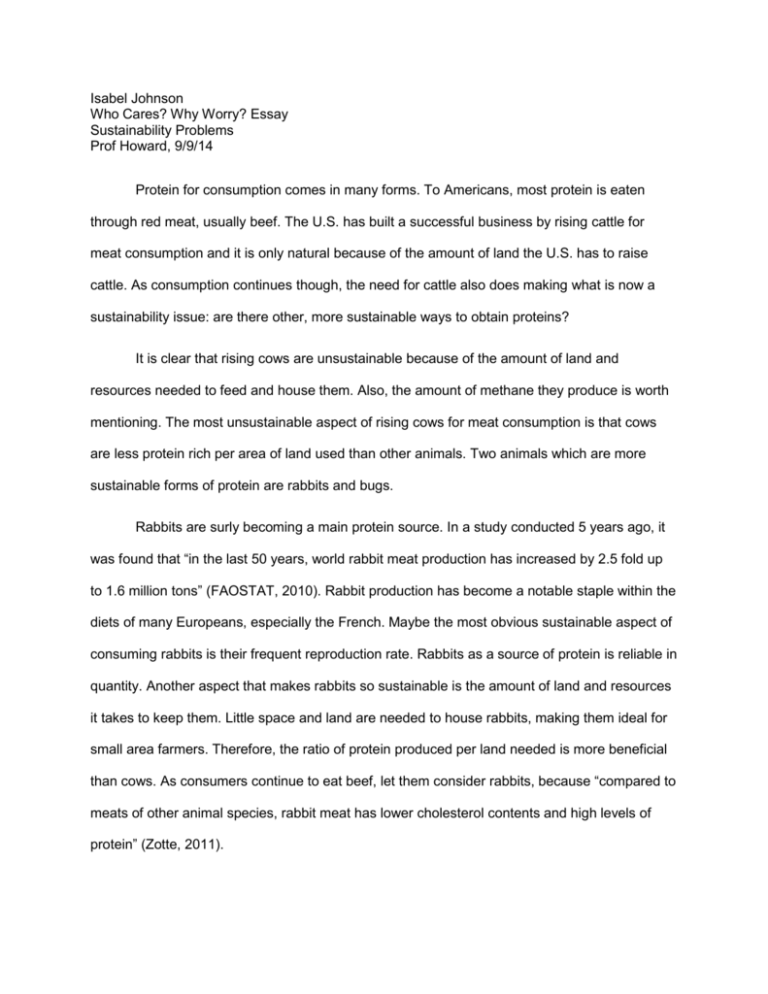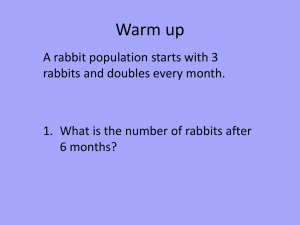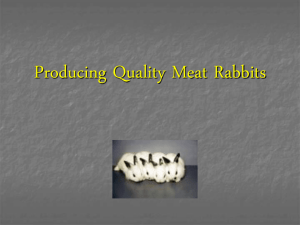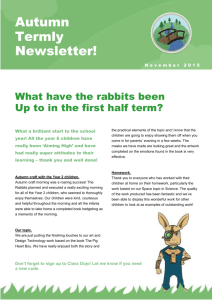JohnsonWhoCares - SustainabilityProblems
advertisement

Isabel Johnson Who Cares? Why Worry? Essay Sustainability Problems Prof Howard, 9/9/14 Protein for consumption comes in many forms. To Americans, most protein is eaten through red meat, usually beef. The U.S. has built a successful business by rising cattle for meat consumption and it is only natural because of the amount of land the U.S. has to raise cattle. As consumption continues though, the need for cattle also does making what is now a sustainability issue: are there other, more sustainable ways to obtain proteins? It is clear that rising cows are unsustainable because of the amount of land and resources needed to feed and house them. Also, the amount of methane they produce is worth mentioning. The most unsustainable aspect of rising cows for meat consumption is that cows are less protein rich per area of land used than other animals. Two animals which are more sustainable forms of protein are rabbits and bugs. Rabbits are surly becoming a main protein source. In a study conducted 5 years ago, it was found that “in the last 50 years, world rabbit meat production has increased by 2.5 fold up to 1.6 million tons” (FAOSTAT, 2010). Rabbit production has become a notable staple within the diets of many Europeans, especially the French. Maybe the most obvious sustainable aspect of consuming rabbits is their frequent reproduction rate. Rabbits as a source of protein is reliable in quantity. Another aspect that makes rabbits so sustainable is the amount of land and resources it takes to keep them. Little space and land are needed to house rabbits, making them ideal for small area farmers. Therefore, the ratio of protein produced per land needed is more beneficial than cows. As consumers continue to eat beef, let them consider rabbits, because “compared to meats of other animal species, rabbit meat has lower cholesterol contents and high levels of protein” (Zotte, 2011). Many do not like the idea of eating bugs. Although it is not the case in the U.S., “80 percent of the world’s population eats insects as a regular part of their diet” (Michels, 2012). Like rabbis, bugs are able to reproduce quickly and frequently; and to an exceedingly larger amount than rabbits. Also similar to rabbits, the amount of space needed to produce them is minimal. For people in developing nations, bugs can be readily found in nature making them very accessible and reliable as a source of protein. An added benefit is that they are low in fat. A cricket averages about 20.5g protein with only 6.8g of fat, while lean beef contains about 26.1g of protein and 11.7g of fat (Martin, 2014). Based on this, it is apparent that bugs are a truly sustainable form of obtaining protein. Overall, rabbits and bugs are identifiable sustainable sources of protein. They both have high reproduction rates, easily kept, and are very protein rich. Unfortunately, the largest barrier keeping these protein sources out of American diets are taste preferences. Recently though, chiefs have been creating delicious rabbit, and bug dishes in hopes of swaying people from the normal beef stake. As land and resources become scarcer, note that there are sustainable proteins available. Stakeholers Involved: People of developing nations Cattle Farmers Asian Market Cookers USDA American Chiefs Small Farm Owners Meat Consumers Works Cited Martin, Daniella. "Stop Adding Protein Powder to Your Post-Workout Shake. Add Bugs Instead." Slate Magazine. Slate, 2014. Web. 09 Sept. 2014. Michels, Spencer. "Bugs for Dinner?" PBS. PBS, 7 May 2012. Web. 09 Sept. 2014. Sifferlin, Alexandra. "Dietary Guidelines Are Not So Sustainable, Study Says." Time. Time, 05 Sept. 2014. Web. 07 Sept. 2014. Walsh, Bryan. "The Triple Whopper Environmental Impact of Global Meat Production | TIME.com." TIME. TIME, 16 Dec. 2013. Web. 07 Sept. 2014. Zotte, Antonella D. "Meat Science." ELSEVIER 88.3 (2011): 319-31.ScienceDirect. Web. 9 Sept. 2014. <http://www.sciencedirect.com/science/article/pii/S030917401100074X>.





